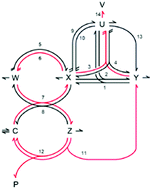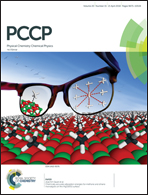Constrained stoichiometric network analysis
Abstract
Stoichiometric network analysis (SNA) is a method for studying the stability of steady states of stoichiometric systems by decomposing the corresponding network into elementary subnetworks (also known as extreme currents) and identifying those that may cause loss of a network's stability via interplay of positive and negative feedback. Experimentally studied complex (bio)chemical reactions often display dynamical instabilities leading to oscillations or bistable switches. When modelling such systems, a frequently met case is that an assumed detailed mechanism in terms of power law kinetics is available, but some of the rate coefficients are unknown and obtaining them by traditional kinetic methods based on a least-square fit is cumbersome or unfeasible. We propose a method combining the SNA and experimental data at the point of instability, which provides an estimate of the unknown rate coefficients along with unknown steady state concentrations. The core of the method rests in using constrained linear optimization to find a combination of the elementary subnetworks such that the dominant instability-causing subnetwork is just counter-balanced by stabilizing effects of all other subnetworks to obtain the instability threshold, and at the same time, the experimentally available data (inflow constraints, measured steady state concentrations of some species, frequency of emerging oscillations, etc.) are exactly matched. We illustrate this approach by examining two classical chemical oscillators: the Brusselator chosen as the simplest model for illustration of our methods and the Belousov–Zhabotinsky reaction and its mechanism represented by the Oregonator model as a more advanced example.



 Please wait while we load your content...
Please wait while we load your content...